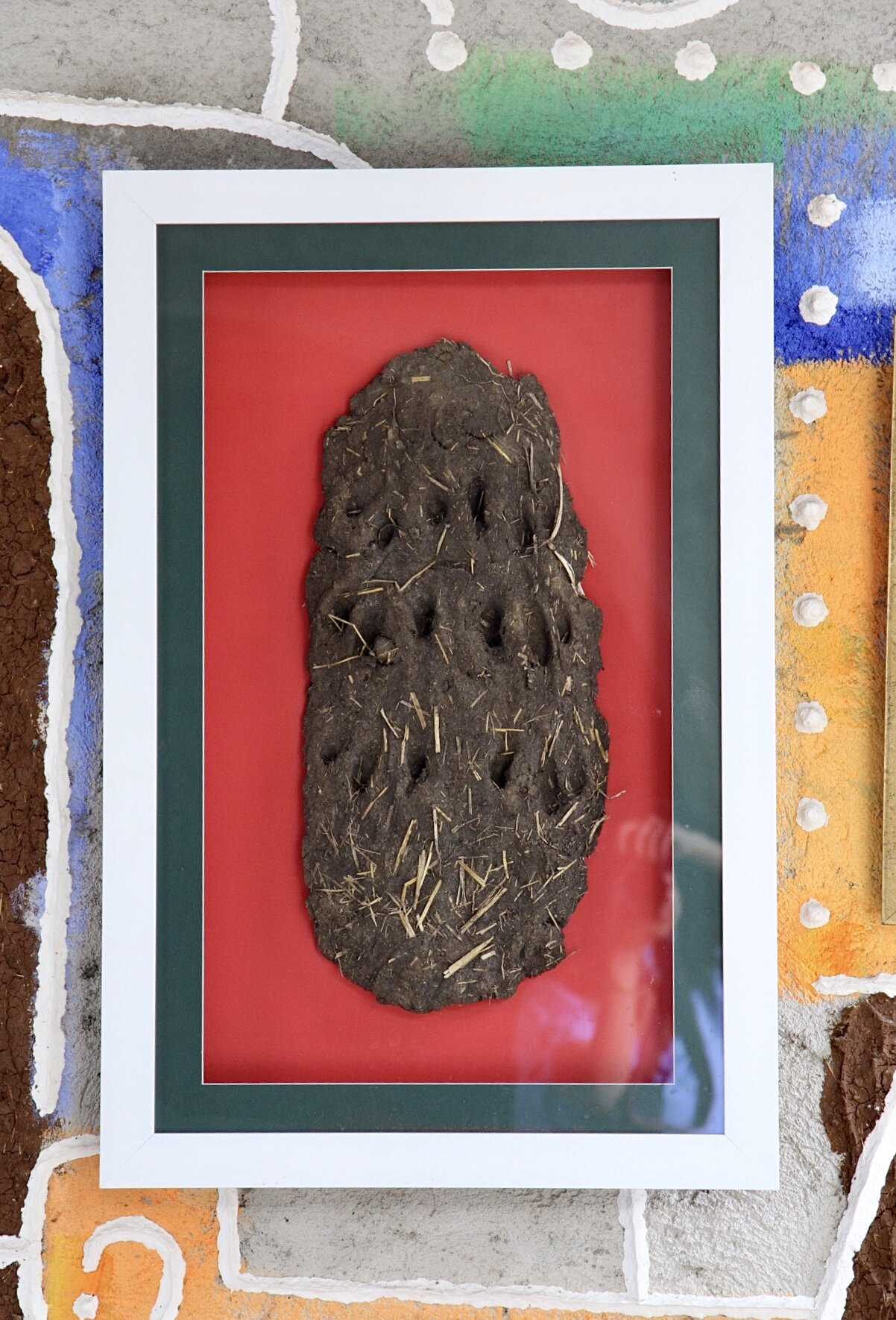Tamrat Gezahegne: Making Art at Fendika, Making Fendika into Art
Photo of Melaku Belay and Tamrat Gezahegne, by Mesfin Abebe
I need people to have their own visual experience,
to interpret the images for themselves, and
to have a dialogue with themselves.
- Tamrat Gezahegne
Photo by Haymanot Honelgne
Lucy (Painted on mud mixed with acrylic)
Lucy goes back 3 million years.
She is deep memory for us.
We all know Lucy.
I deliberately placed the bones -
head, pelvis, ribs -
to shift away from the known image.
I want to remind people
they can create their own image in their minds.
Danteil on Radio
Bright-colored danteil (ዳንቴል)
Homemade crochet
How we show respect
by covering religious pictures or a radio
in our homes
Photo by Haymanot Honelgne
Kubet (ኩበት cow dung mixed with grass, framed)
I bought the cow dung in Addis Ababa
at a local market between Arat Kilo and Shero Meda.
People are amazed by the kubet;
They don’t expect it to be in a fancy frame.
But seeing kubet evokes layers of feelings
and memories for Ethiopians,
because we grow up with this.
We buy cow dung from the market and use it for fuel
to bake injera or dabo.
It is ancient knowledge to use kubet for fuel or fertilizer.
I don’t know who invented this.
There is a lot of cow dung in the countryside.
People mix it with water
to paint the inside of the house.
It has its own beauty -
a dark greenish color.
A natural beauty, especially
with the incense burning in the house.
It’s very beautiful.
Mud (on concrete)
I prepared the mud from soil and water,
the traditional way – no chemicals.
I stirred and mixed it for 6 days before it was ready.
I made geometric patterns with the mud on the concrete wall
To represent the urban, where
mud houses are giving way to concrete buildings.
Mud has been used to build in Ethiopia -
be it Menelik’s palace or local houses.
The walls are made of mud mixed with dry grass.
In Tigray, the stones are bound together
by mud
to keep the houses standing
for centuries.
Dots and Lines (white paper Mache)
The dots are meditation:
focus, contemplation, prayers.
They are the moments
when you connect to yourself,
when you listen to yourself.
Like the rosary beads, they arrive
again and again.
The dots are mixed with the lines:
Everything has its own end and beginning.
Photo by Haymanot Honelgne
Sound Memories (Found objects)
The round metal plate
was the top of a tool box
that belonged to a metal repair man.
I bought it from him.
Imagine
when it was new,
it must have been flat and shiny.
But he patched it up over and over again.
Imagine
the layers of sounds
Stored in its memory.
The slotted metal plates and wired metal basket
Held charcoals, burned
to make bunna and melt incense.
Imagine
the sound of flames licking the metal,
of charcoal dust falling through the slots
when swirls of incense adorn the air.
Imagine
the crackling of the wood when it was burned.
Imagine
the swishing of this broom against someone’s floor.
Imagine
The notes that come out of a saxophone
when musicians push down buttons that are perfectly round -
black and gold.
Decorated Wooden Stick (stick, fabric and paper Mache)
Respect.
Patterns.
When you enter a sacred space,
you see things with patterns.
Patterns bring out the contemplative spirit.
I need my work to take people to that feeling.
At the same time,
people also interpret it on their own.
Photo by Haymanot Honelgne
A Small Part of A Tree
I like its organic shape.
I mixed it with geometric objects,
such as a frame.
What do you see?
Photo by Haymanot Honelgne
Saint Yared’s Nota
The father of Ethiopian music
Saint Yared
created musical notes in the 6th century.
I melded his 10 notes with Western music notes
to create this new stage background in Fendika.
Perhaps some musicians will be inspired by the image
and make new music in the future.
Who knows?
My work is …
Coalescence
Bringing together
Images and sounds
Shapes and lines
Lifeways, knowledge, thoughts
Stories, poetry
Mutual acceptance
Human with nature
People with each other -
Urban or rural
Ethiopian and elsewhere
Going hand in hand
Photo by Haymanot Honelgne
For more about this installation, please see “The Story Told by a Fendika Table”
At Fendika
You hear indigenous music of Ethiopia,
but also experimental music.
Like in my work, there is a
coalescence
of rural and urban,
organic and geometric.
People come to Fendika to share ideas.
I come to listen to music and
to meet my friends
every Monday and Friday night.
I used to sit by this table at Fendika;
It started telling me its story, its journey.
Touched by the table’s contemplation,
I turned it into art on Fendika’s wall.
During the day,
I come here
whenever I feel inspired to work.
I’m creating a new work for the ceiling of the pavilion –
invented alphabet symbols based on
my studies
of many cultures of Ethiopia.
I met Melaku before 2014 when Netsa Art Village was
demolished.
He used to visit the Village.
Now there is rapid construction in Addis.
They want to demolish traditional houses (like Fendika).
We can encourage people to keep our houses like this
by making them into art.
If there is art in the house, it becomes art.
Then demolishing the house
will be at the level of demolishing art.
Maybe
we’ll have a chance to keep the house.
Photo by Haymanot Honelgne
For more about this installation, please see “The Story Told by a Fendika Table”.
Photo by Haymanot Honelgne
To learn more about Tamrat’s work, please visit his website: tamratgezahegne.com








